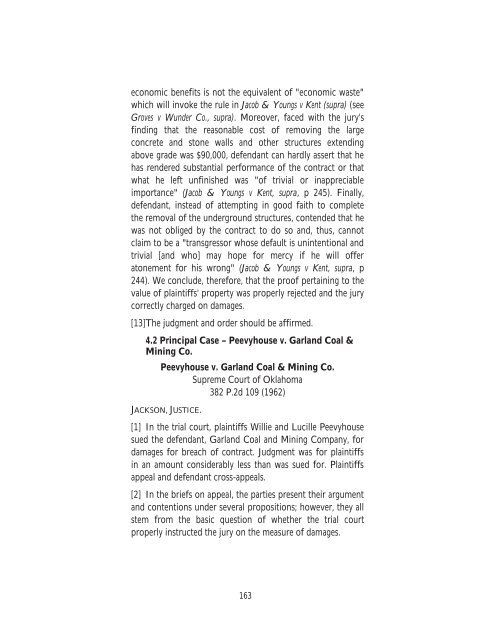Contract Doctrine, Theory & Practice Volume 3, 2012a
Contract Doctrine, Theory & Practice Volume 3, 2012a
Contract Doctrine, Theory & Practice Volume 3, 2012a
Create successful ePaper yourself
Turn your PDF publications into a flip-book with our unique Google optimized e-Paper software.
economic benefits is not the equivalent of "economic waste"<br />
which will invoke the rule in Jacob & Youngs v Kent (supra) (see<br />
Groves v Wunder Co., supra). Moreover, faced with the jury's<br />
finding that the reasonable cost of removing the large<br />
concrete and stone walls and other structures extending<br />
above grade was $90,000, defendant can hardly assert that he<br />
has rendered substantial performance of the contract or that<br />
what he left unfinished was "of trivial or inappreciable<br />
importance" (Jacob & Youngs v Kent, supra, p 245). Finally,<br />
defendant, instead of attempting in good faith to complete<br />
the removal of the underground structures, contended that he<br />
was not obliged by the contract to do so and, thus, cannot<br />
claim to be a "transgressor whose default is unintentional and<br />
trivial [and who] may hope for mercy if he will offer<br />
atonement for his wrong" (Jacob & Youngs v Kent, supra, p<br />
244). We conclude, therefore, that the proof pertaining to the<br />
value of plaintiffs' property was properly rejected and the jury<br />
correctly charged on damages.<br />
[13] The judgment and order should be affirmed.<br />
4.2 Principal Case – Peevyhouse v. Garland Coal &<br />
Mining Co.<br />
Peevyhouse v. Garland Coal & Mining Co.<br />
Supreme Court of Oklahoma<br />
382 P.2d 109 (1962)<br />
JACKSON, JUSTICE.<br />
[1] In the trial court, plaintiffs Willie and Lucille Peevyhouse<br />
sued the defendant, Garland Coal and Mining Company, for<br />
damages for breach of contract. Judgment was for plaintiffs<br />
in an amount considerably less than was sued for. Plaintiffs<br />
appeal and defendant cross-appeals.<br />
[2] In the briefs on appeal, the parties present their argument<br />
and contentions under several propositions; however, they all<br />
stem from the basic question of whether the trial court<br />
properly instructed the jury on the measure of damages.<br />
163


















